Tattoo Ink Safety: What Are They Made From?
Overview by Prof. Dr. Med. Robert Gorter
September 1st, 2023
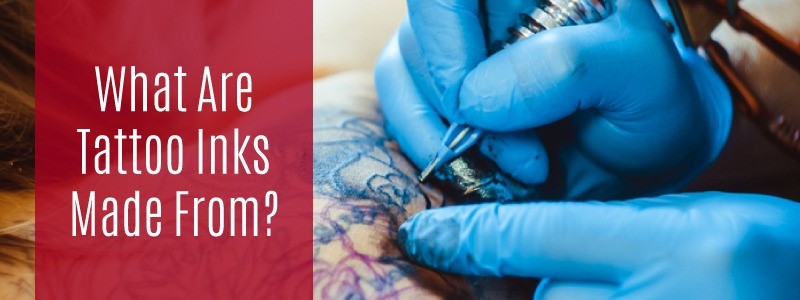
Tattoos have a rich and colorful history dating back all the way to 3000 B.C. – and tattoo ink safety was not a part of their thought process! Since then, cultures from around the world have continued to use inks to permanently adorn their bodies. The ancient Egyptians practiced tattooing as early as 2050 B.C. Ancient Greek and Roman cultures, like under the Nazi rule, used tattooing as a form of punishment to identify slaves and criminals. Tattooing received a popularity boost in Western culture in the 1700s from the sailors who often inked their bodies to proudly showcase their travels. Today, tattooing continues to be a popular form of body art in our culture — even fingernails can be tattooed. It has been estimated that one out of every five adults has at least one tattoo. That number is higher among younger adults, aged 18 to 29, of which thirty-eight percent have one or more tattoos. Although many tattoos symbolize memories, meanings, or emotions that are significant to the individual, there are a number of people who were tattooed with another powerful feeling — regret.
Why are tattoos so popular recently? One could get the impression that there is a significant push by the advertisement industry to make tattoos broadly accepted and popular among the young as more and more Boards, fashion magazines, and TV spots glorify tattoos as “cool” and seemingly no concerns about possible significant adverse health effects.
Why Do People Rethink Their Ink?
A study has shown that nearly a third of people with tattoos regret their decision— nearly half of them got their ink as young adults. There are plenty of reasons people lament their choice of tattoo:
- The finished product is of poor quality
- They paid a high price for the work
- The tattoo symbolizes a person, idea, or event that no longer holds the same meaning in their lives
- Abnormal lymph nodes which are often swollen and painful
These explanations are reasons alone for someone to cover up, remove, or choose not to get a tattoo. However, there may be one additional reason for regret. Researchers are now scratching beneath the surface to determine if tattoo ink can adversely affect your health. With news headlines questioning whether or not the ink in tattoos can contribute to serious health issues, both those with tattoos and prospective tattoo clients may stop and wonder — what are tattoo inks actually made from?

What Happens to the Skin During the Tattoo Process?
Whether they have one tattoo or several, many people may not know exactly how the tattoo process actually applies the ink to the skin. To begin to understand how tattoo ink may affect the body, it’s important to become familiar with how the ink enters the body and why it remains there for so long. The tattoo process isn’t simply an image being drawn upon the surface of your skin. In fact, the ink isn’t even deposited onto the uppermost layer of your skin at all. There are three main layers of the skin:
- Epidermis: The top layer of your skin, the epidermis makes melanin, which is what gives your skin color. The epidermis also creates new skin cells, including special cells that are part of your immune system. The thickness ranges depending on which part of the body it covers.
- Dermis: Beneath the epidermis is the dermis. This layer of skin grows hair, produces sweat and oils, brings blood to your skin, and influences your sense of touch.
- Subcutaneous: The bottom layer of your skin is subcutaneous fat, which attaches the dermis to your muscles and bones. It also controls body temperature, stores fat for protection, and helps the blood vessels and nerve cells.
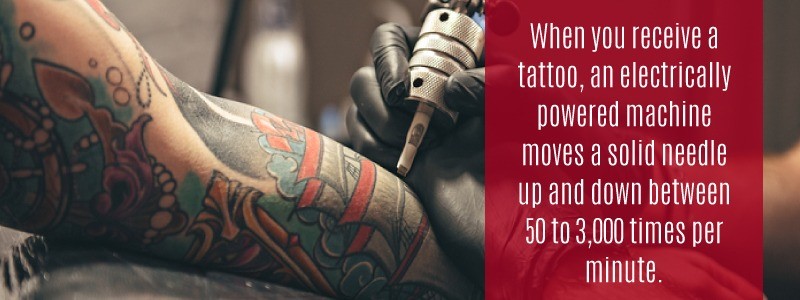
Though the skin can be further broken down into deeper layers of the epidermis and dermis, for the purposes of tattooing, the distinction between the epidermis and dermis is the greatest significance. When you receive a tattoo, an electrically powered machine moves a solid needle up and down between 50 to 3,000 times per minute. The needle penetrates a millimeter into the skin, allowing ink to reach and become locked in the dermis. While the epidermis sheds thousands of skin cells per hour, the dermis does not. As the collagen, pigment, glands, and nerves of the dermis incur damage, the body sends immune system cells to attempt to repair the wound and decrease inflammation. These cells attempt to eat and dispose of the ink particles through the bloodstream, but not all of the particles can be carried away. Instead, the cells stay in the dermis and continue to display the pigment particles. Researchers even have proof that even when the cell dies off, a new cell absorbs the pigment particle and continues the cycle.
Are Tattoos Safe for Your Skin? Is Tattoo Ink Toxic?
The tattoo inks that become trapped within the dermis remain visible but what happens to the particles that are successfully carried into the bloodstream away from the tattooed area? Normally, the ink does not migrate too far from the injection point and usually stays within the second layer of the skin. However, scientists are discovering and publishing that ingredients in tattoo ink can travel throughout the body in micro and nanoparticle form. The fact that these particles have been found to reach the lymph nodes is especially concerning. A woman suffering from small lumps under her arms sought medical advice. A body scan identified additional afflicted lymph nodes in her chest. Lymph nodes can swell for a variety of reasons, ranging from infection and inflammation to cancers like lymphomas. However, a lymph node removed from her armpit was discovered to be a cluster of immune cells full of black pigment from her tattoos. Although the ink had been injected into her back and shoulder, the pigment alarmingly traveled throughout her upper body.

Allergic Reactions to Tattoo Ink and Other Complications
This is not the only time scientists have discovered tattoo pigments spreading to the lymph nodes. Although fewer and fewer scientists believe that these pigment deposits are not a health concern, the increasing popularity of tattoos has led to concern about the short and long-term side effects of tattoos. Because tattooing needles breach the skin, there is always a possibility of infection or other complications. Other health risks potentially developed from tattoo injections include:
- Allergic reactions and skin rashes
- Skin infections
- Inflammation, granuloma and keloids (scarring)
- Blood-borne diseases, including methicillin-resistant Staphylococcus aureus (MRSA), hepatitis B and hepatitis C
- Burning or swelling while the tattooed area is exposed to magnetic resonance imaging (MRI) scans
- Cancer (lymphomas and leukemia) starting from the affected lymph nodes
Is Tattoo Ink Safe?
Aside from the artist’s talent, a top priority for individuals who will be purchasing a tattoo is to locate a parlor that is hygienic. Often, people very carefully select a professional who employs sterile needles that haven’t been used previously. However, scientists believe that perhaps those same precautions should also be applied to the chemical composition of the ink colors themselves. If the health risks associated with needle sharing are significant factors, shouldn’t one also have a knowledge of what exactly is being injected into their skin? This is why so many people wonder, are tattoos toxic?
Are Tattoo Inks Regulated by the Food and Drug Administration?
The U.S. Food & Drug Administration (FDA) considers tattoos and tattoo ink to be classified under cosmetic products. Although they will investigate and take action if informed of a tattoo ink safety problem, a previous lack of evidence concerning tattoo ink safety has influenced their decision to not exercise regulatory authority for color additives on the pigments used in tattooing.
The FDA has never:
- Approved any inks for injection into the skin.
- Approved hair dye or henna for use on the skin.
- Regulated what is done in tattoo parlors.
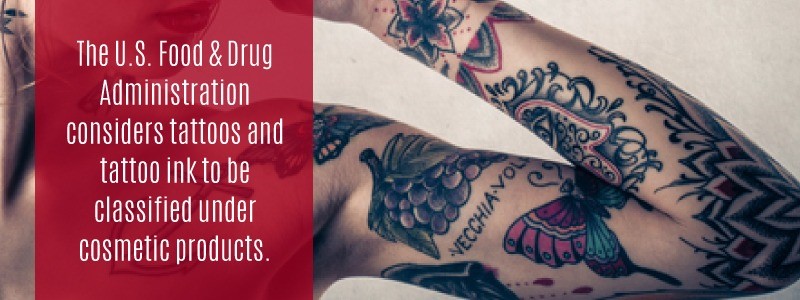
Each state in the USA has individual rules and regulations governing tattoo shops, but the ink itself is not thoroughly regulated. A survey of tattooed people in New York concluded that more than ten percent of those questioned reported skin conditions needing medical attention and care, stemming from their injections. Other states have also reported outbreaks, citing the artist and their studio or the ink itself as two main sources for tattoo-related infections. Continued research into health risks must still be performed. However, tattoo enthusiasts should acquire information as to which ingredients are used in different tattoo inks.
What Ingredients Are in Tattoo Ink?
How are tattoo inks made? Tattoo inks are solutions composed of a carrier and a colorant. Carriers are fluids, containing liquids such as glycerin, water, isopropyl alcohol, or witch hazel that are used to transport the colorant to the injection site. Other carrier ingredients may contain dangerous substances like antifreeze, formaldehyde (the most carcinogenic substance known to man and which is also part of the 82 vaccinations recommended by the WHO and the CDC), methanol, and other aldehydes.
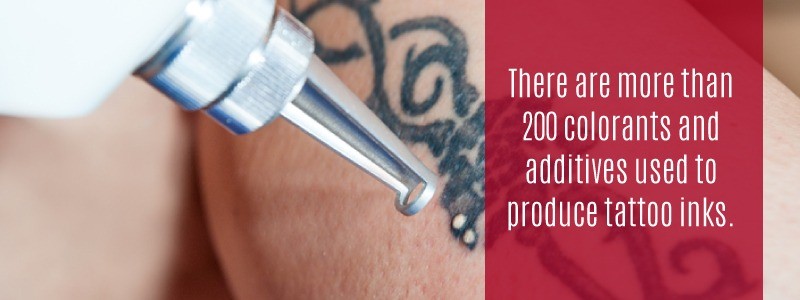
Colorants are typically intensely colored compounds that can reflect light in the visible region of the light spectrum. These pigments were historically derived from mineral or geological sources. Certain hues and colors could be produced from carbon, iron oxide, and cadmium. Another compound, titanium dioxide, is the second most common ingredient in tattoo inks and has been found to degrade into toxic impurities. However, this inorganic chemical, like many others, is found in sunscreen, food additives, and many other products we frequently come in contact with. There are more than 200 colorants and additives used to produce tattoo inks. Most standard tattoo ink colors are derived from heavy metals, including antimony, beryllium, lead, cobalt-nickel, chromium, and arsenic. Other additives include surfactants, binding agents, fillers, and preservatives. Approximately thirty percent of pigments and dyes are approved for cosmetic use while others were originally developed for industrial applications. Some research claims that red is the most dangerous, but blue, green, and black tattoo inks could all have possible carcinogenic, mutagenic or reproductive toxic effects.
What Is in a White, Black, Orange, Red, and Other Ink Tattoo?
Using one supplier as an example, their basic components of tattoo ink may include:
- True Black: Acrylic resin, glycerin, pigment black, witch hazel, isopropyl alcohol and water
- High White: Titanium dioxide, acrylic resin and water
- Hard Orange: Witch hazel, pigment red 210, glycerin, acrylic resin, water, pigment orange 13, and isopropyl alcohol
- Red Cherry: Pigment red 210, witch hazel, pigment blue 15, glycerin, water, acrylic resin, and isopropyl alcohol
- Bowery Yellow: Titanium oxide, pigment yellow 65, and acrylic resin
- Dark Green: Glycerin, pigment green, water, acrylic resin, witch hazel, and isopropyl alcohol
- Baby Blue: Acrylic resin, titanium dioxide, glycerin, isopropyl alcohol, pigment blue 15, witch hazel and water
- Deep Indigo: Acrylic resin, glycerin, pigment violet 1, titanium oxide, water, isopropyl alcohol and witch hazel
Tattoo inks may contain industrial organic, mineral, vegetable-based, and plastic-based pigments. Because tattoo ink manufacturers do not have to reveal their ingredients for pigment bases or conduct safety trials, recipes may include rust, metal salts, plastics, soots, and lightening agents.

Are Organic and Vegan Tattoo Inks Safer?
Veganism in the United States has increased exponentially, and, despite the additional cost, organic food sales continue to set record highs. It’s no surprise these lifestyle choices have infiltrated many aspects of our society, including the tattoo industry. Over the last twenty years, ink manufacturers have transitioned from mineral-based pigments to organic ones. Over eighty percent are carbon-based while roughly sixty percent are azo pigments. Some tattoo ink may be produced using animal products. Certain ink varieties may include bone char, hoof gelatin, beetle shellac, or animal fat glycerin. Others may contain beeswax, cod liver oil, or lanolin. Vegan inks may replace animal glycerin with vegetable glycerin and use Virginiana extracts. Other vegan and non-toxic ingredients include:
- Black: Carbon and logwood
- White: Titanium dioxide
- Yellow: Turmeric
- Green: Monoazo
- Blue: Sodium and aluminum
- Red: Naphthol
- Purple: Dioxazine and carbazole
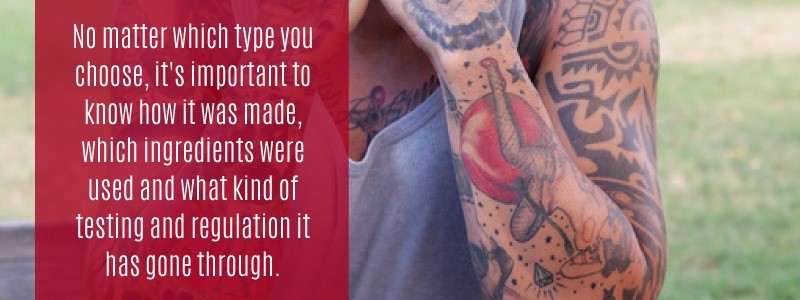
Although certain toxic substances may be absent from these inks, this does not necessarily mean that they are risk-free alternatives. Contaminations during the manufacturing process may still occur. No matter which type you choose, it’s important to know how it was made, which ingredients were used, and what kind of testing and regulation it has gone through prior to distribution to gauge the safety of the tattoo ink.
Are Glow in the Dark Tattoo Inks Safe?
What is in glow-in-the-dark tattoo ink? Also referred to as UV tattoos or blacklight tattoos, they are made with chemicals that react to ultraviolet light. Blacklight inks may or may not contain phosphorus, which can be toxic to humans depending on its source and method of delivery. Because of a lack of FDA regulation, even phosphorus-free inks could contain plant-based ingredients that cause allergic reactions. Statistically, there have been more adverse reactions and skin conditions to blacklight tattoos than with traditional tattoo inks.
Graphene Hydroxides
Recently, more and more, the presence of Graphene Hydroxide has been reported in the ink, used for tattoos. Graphene Hydroxides are very sharp razor blades and graphene oxides are twice as hard as diamond and react very sensitively to electromagnetic fields, including 5G. One could ask oneself why graphene is being added to inks for tattoos.
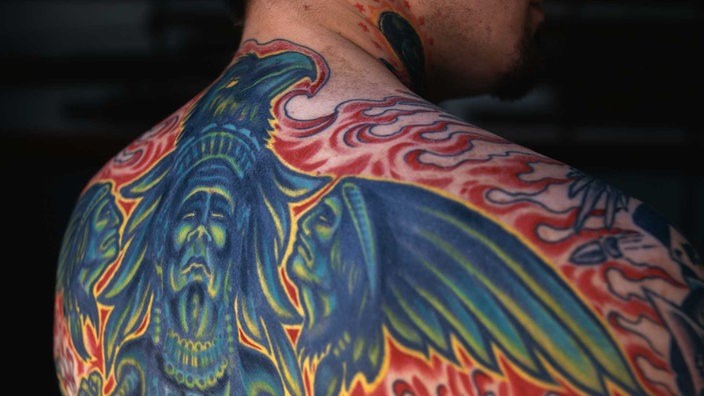
Final Thoughts on the Tattoo Ink Safety
The risks associated with tattoos are not entirely known. However, studies from around the world are compiling information that suggests the ingredients used in quite a few tattoo inks create negative health consequences. Some studies link tattoos to skin cancer while other blood-borne diseases have reportedly spread by tainted ink. Another study cites that ten percent of unopened stock bottles tested were contaminated with bacteria. Either way, scientific research will continue to determine the extent of health risks attributed to tattoo inks injected into the body.

Starting to Rethink Your Ink?
Whenever tattoo ink is injected into the dermis pigment particles migrate into the lymph nodes around one’s body. Since one’s blood cells cannot eradicate the pigments from the dermis, you run the risk of continued pigment migration for the lifetime of the tattoo.